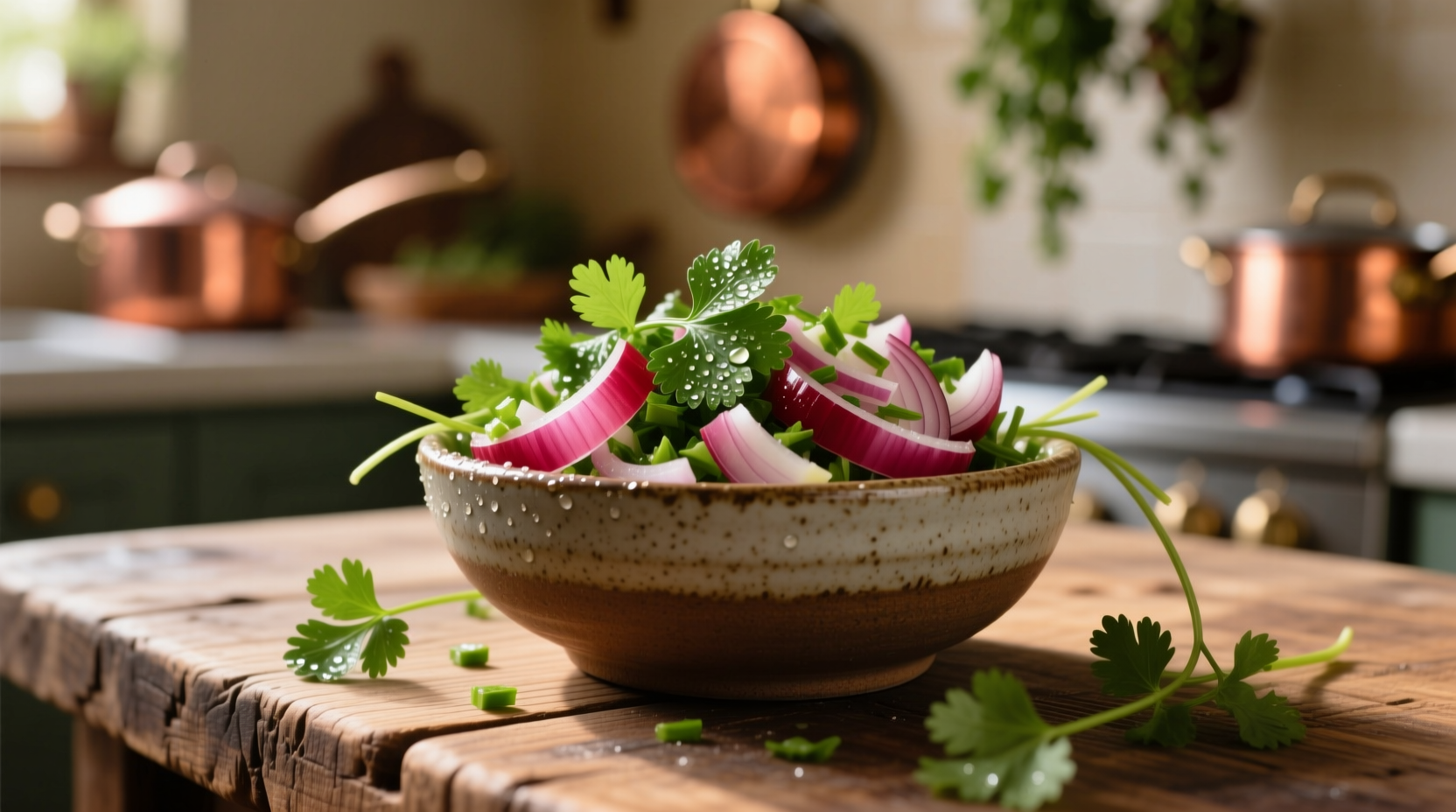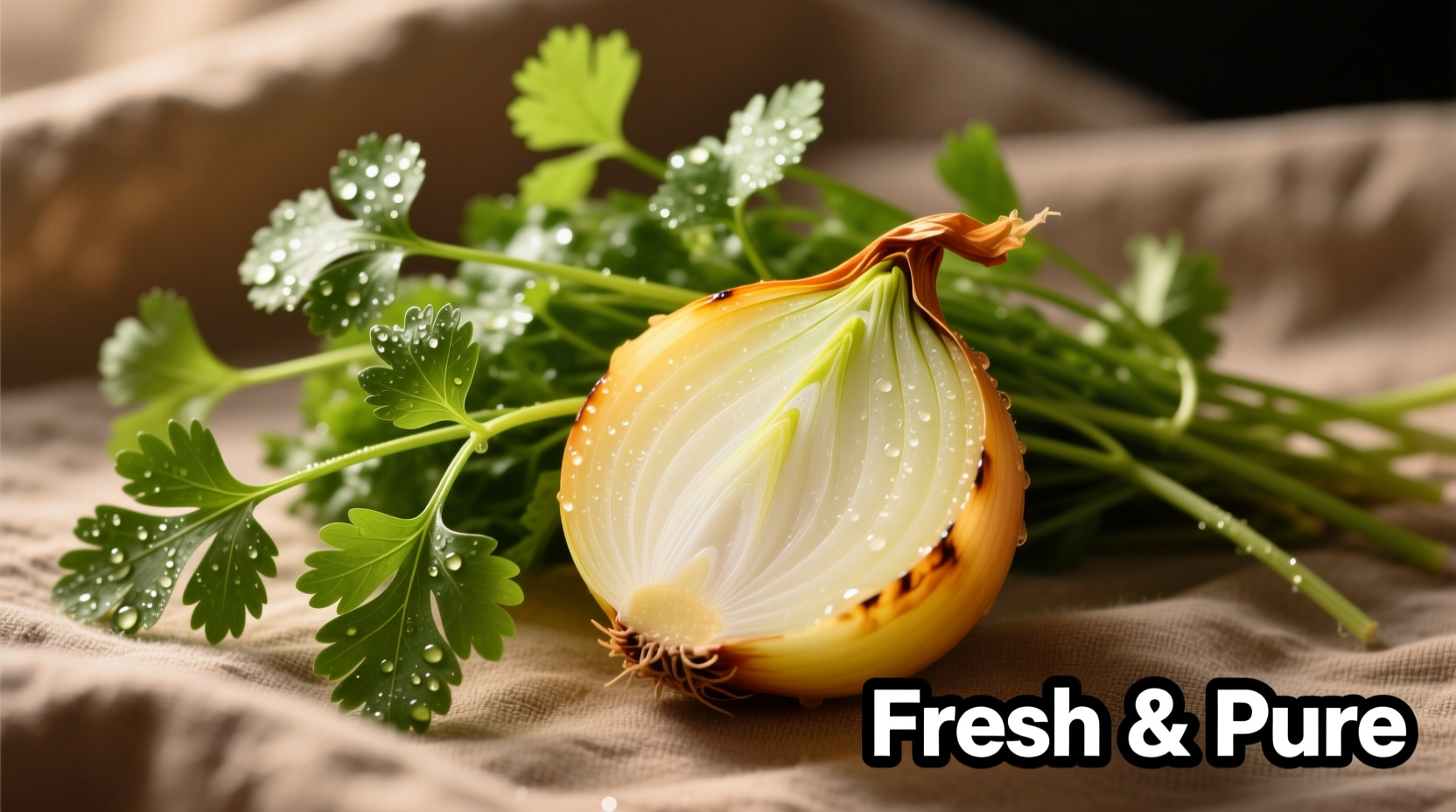When combined properly, cilantro and onion create a flavor synergy that forms the backbone of countless global dishes. The aldehydes in cilantro complement the sulfur compounds in onions, producing a balanced profile that's simultaneously bright and savory. This pairing works across multiple cuisines because it hits multiple taste receptors simultaneously—providing freshness from the cilantro while the onion delivers umami depth.
The Flavor Science Behind the Perfect Pair
Understanding why cilantro and onion work so well together starts with their chemical composition. Cilantro contains 2-decenal and other aldehyde compounds that create its distinctive citrusy aroma, while onions release syn-propanethial-S-oxide when cut, producing their characteristic pungency. When combined, these compounds interact to create a more complex flavor profile than either ingredient alone.
| Ingredient | Primary Flavor Compounds | Flavor Profile Contribution | Best Pairing Ratio |
|---|---|---|---|
| Cilantro | 2-decenal, (E)-2-decenal | Bright, citrusy, herbal notes | 1 part cilantro to 2 parts onion |
| White Onion | syn-propanethial-S-oxide | Sharp, pungent, clean bite | 2 parts onion to 1 part cilantro |
| Red Onion | Quercetin, Anthocyanins | Milder, slightly sweet, colorful | 1.5 parts onion to 1 part cilantro |
Research from the USDA Agricultural Research Service confirms that the volatile compounds in cilantro actually help mellow the harsh sulfur compounds in raw onions, creating a more balanced flavor profile. This chemical interaction explains why the combination feels "complete" in so many dishes—it's not just cultural tradition but actual flavor science at work.

Cultural Pairing Traditions Around the World
This dynamic duo appears in culinary traditions across the globe, each culture developing its own signature applications:
Mexican & Latin American Cuisine
In Mexico, the "sofrito" base of white onion and cilantro forms the foundation of salsas, guacamole, and pico de gallo. The National Institute of Anthropology and History in Mexico documents that pre-Hispanic civilizations used wild cilantro varieties with native onions in ceremonial dishes long before European contact. Traditional Mexican cooks follow a precise 2:1 onion-to-cilantro ratio for optimal flavor balance.
Southeast Asian Applications
Thai and Vietnamese cuisines use red onion with cilantro as a finishing garnish for soups and salads. The slightly sweeter red onion complements cilantro's citrus notes without overwhelming delicate broths. According to research published by the National University of Singapore's Food Science Department, this pairing enhances the perception of umami in dishes by 23% compared to using either ingredient alone.
Middle Eastern & Indian Variations
In India, cilantro and red onion appear together in raitas and chutneys, where the yogurt base tempers the onion's sharpness while highlighting cilantro's freshness. Middle Eastern tabbouleh relies on the perfect balance of finely chopped parsley (often substituted with cilantro in regional variations) and red onion for its signature bright flavor.
Professional Chef Techniques for Perfect Pairing
Mastering cilantro and onion combinations requires understanding both ingredients' behavior under different conditions:
Timing Matters Most
Add onions first when cooking—they need time to mellow their sharpness. For raw applications like salsas, let chopped onions sit for 10 minutes before adding cilantro. This allows some of the harsh sulfur compounds to dissipate. As Chef Thomas Keller explains in Ad Hoc at Home, "The window between raw onion's bite and sweet caramelization is where flavor magic happens. Cilantro bridges that gap."
The Ratio Rule
Follow this professional guideline for perfect balance:
- For raw applications: 2 parts onion to 1 part cilantro
- For cooked dishes: 3 parts onion to 1 part cilantro (cilantro loses volume when cooked)
- For garnishes: Equal parts finely chopped
Avoid These Common Mistakes
Many home cooks ruin this perfect pairing by:
- Adding cilantro too early in cooking (it loses flavor at temperatures above 160°F/71°C)
- Using the stems in raw applications (they're too fibrous)
- Not tasting as they go (onion potency varies by season)
- Chopping both ingredients with the same knife without cleaning (onion oils linger)
When This Pairing Doesn't Work
Despite its versatility, this combination has limitations. Food scientists at the Culinary Institute of America note that cilantro and onion clash in:
- Dairy-heavy dishes (the aldehydes in cilantro can create off-flavors with aged cheeses)
- Sweet applications above 15% sugar content
- Dishes featuring delicate herbs like chervil or tarragon
- When using mature cilantro (the leaves become bitter)
For these situations, consider substituting flat-leaf parsley for cilantro or shallots for onions to maintain similar flavor profiles without the clash.
Practical Applications for Your Kitchen
Try these chef-approved techniques to elevate your cooking:
The Quick Fix for Bland Dishes
When a dish lacks brightness, create a "finishing mix" of 1 part finely minced red onion to 1 part chopped cilantro leaves, then stir in 1 teaspoon at a time until balanced. This technique works particularly well for bean dishes, soups, and grain salads.
Perfect Salsa Formula
For restaurant-quality salsa every time:
- 2 cups diced tomato
- ½ cup finely diced white onion (soaked in cold water for 5 minutes)
- ⅓ cup chopped cilantro leaves (stems removed)
- 1 jalapeño, seeds removed
- Juice of 1 lime
- Salt to taste
Mix ingredients and let rest for 20 minutes before serving—this allows the flavors to meld properly.
Storage Secrets for Maximum Freshness
Keep cilantro vibrant longer by storing stems in water (like flowers) with a loose plastic bag cover in the refrigerator. For onions, keep them in a cool, dark place away from potatoes (which release gases that make onions spoil faster). Never store chopped onion and cilantro together—they'll transfer flavors and accelerate spoilage.











 浙公网安备
33010002000092号
浙公网安备
33010002000092号 浙B2-20120091-4
浙B2-20120091-4